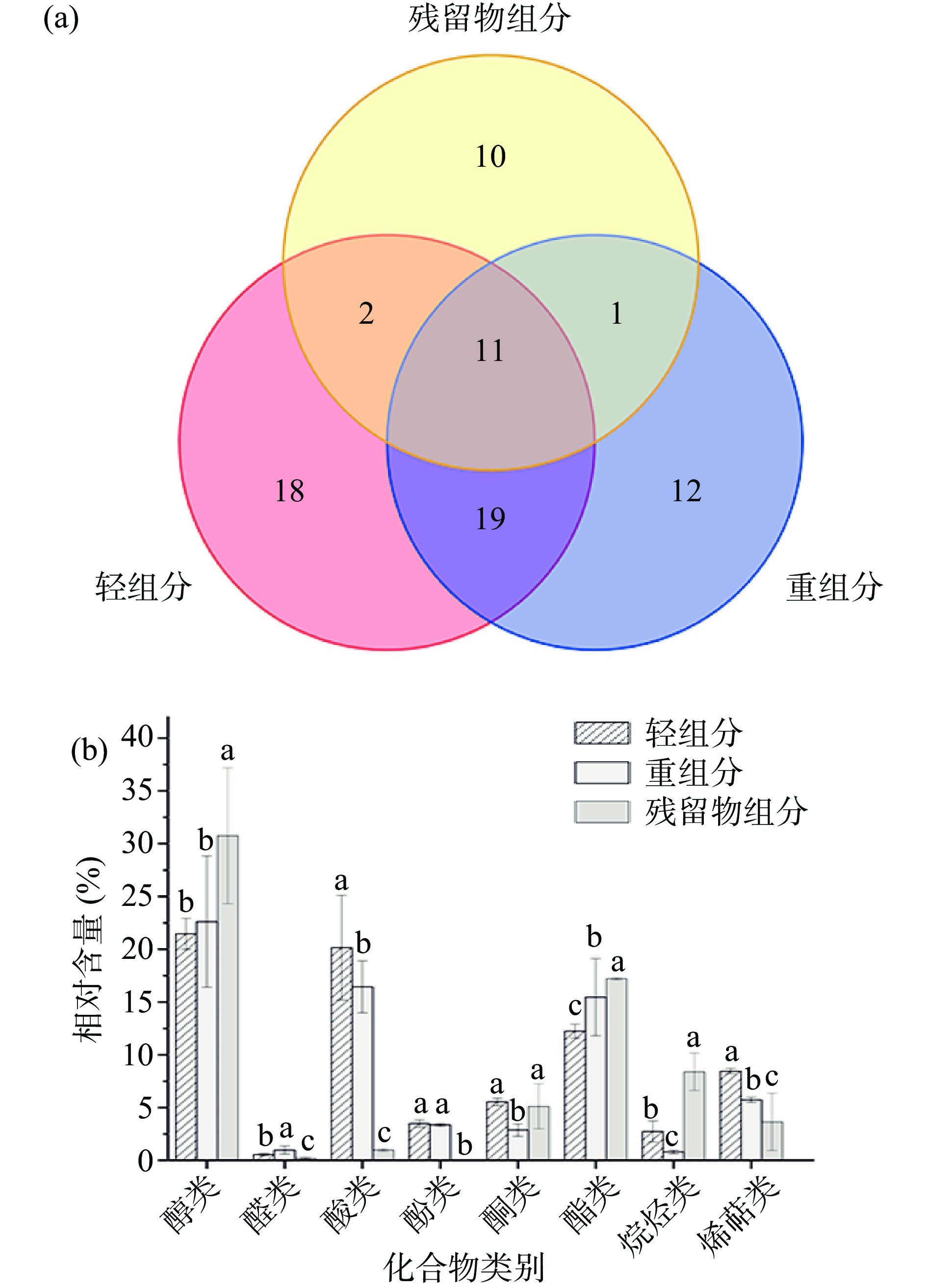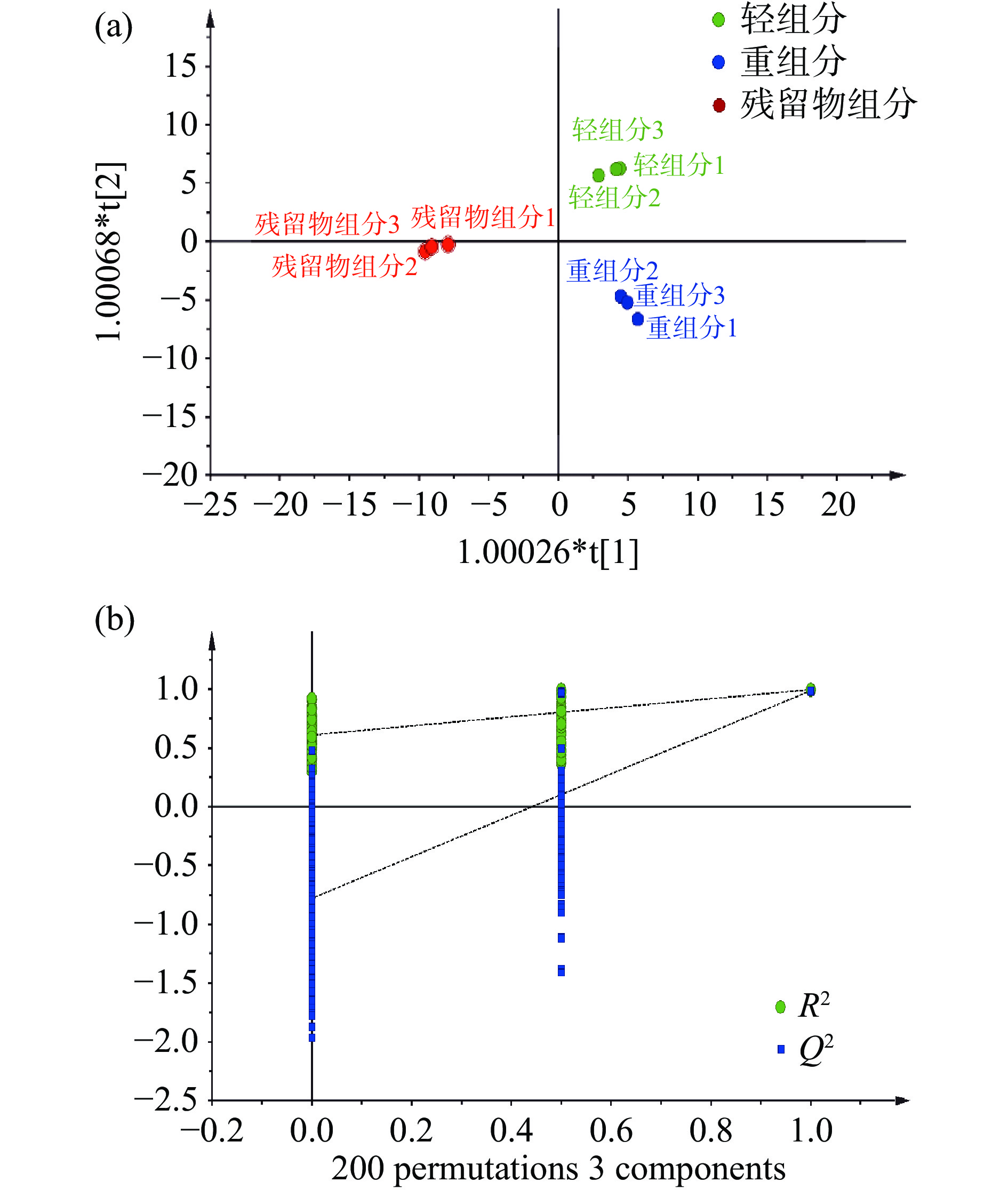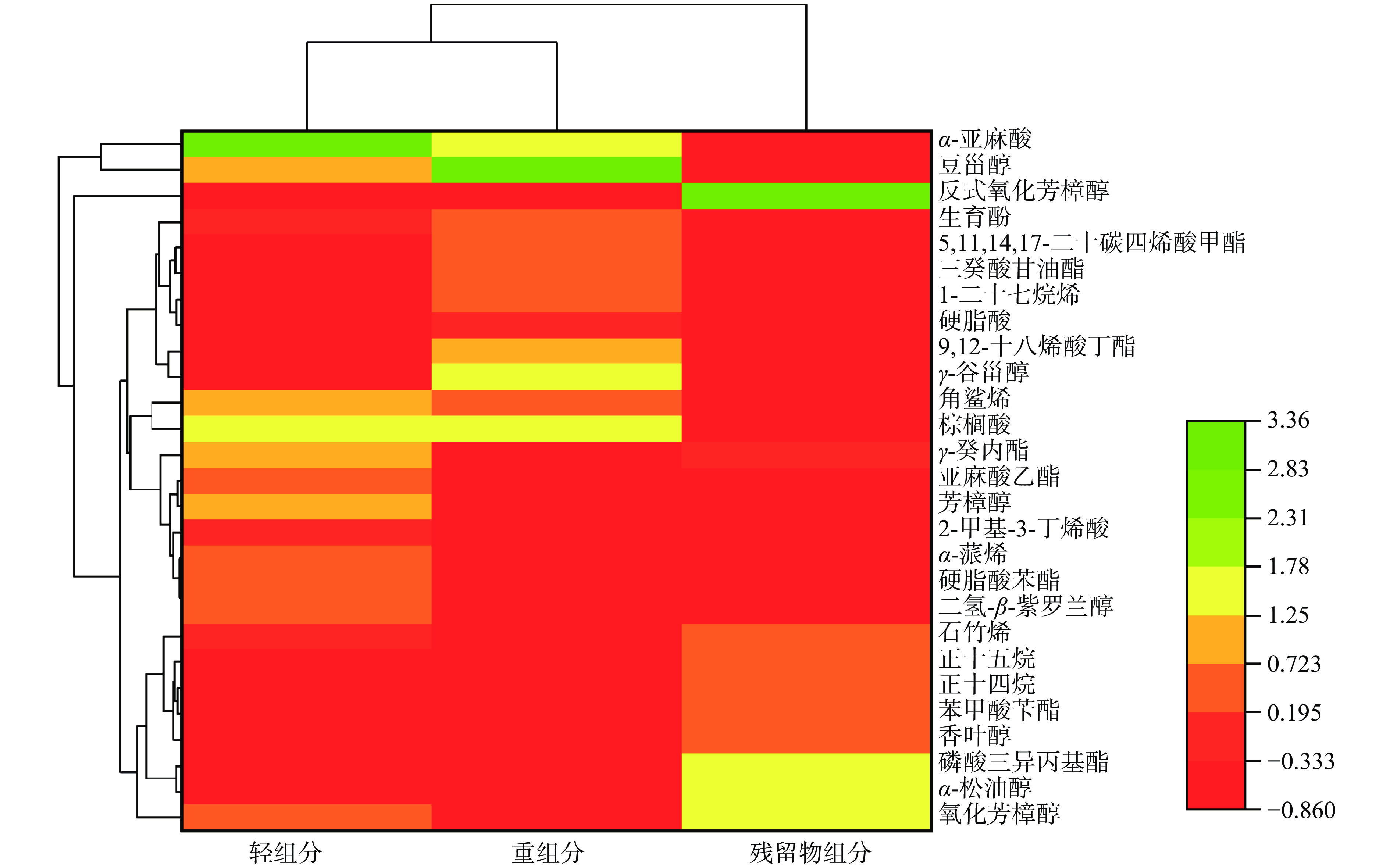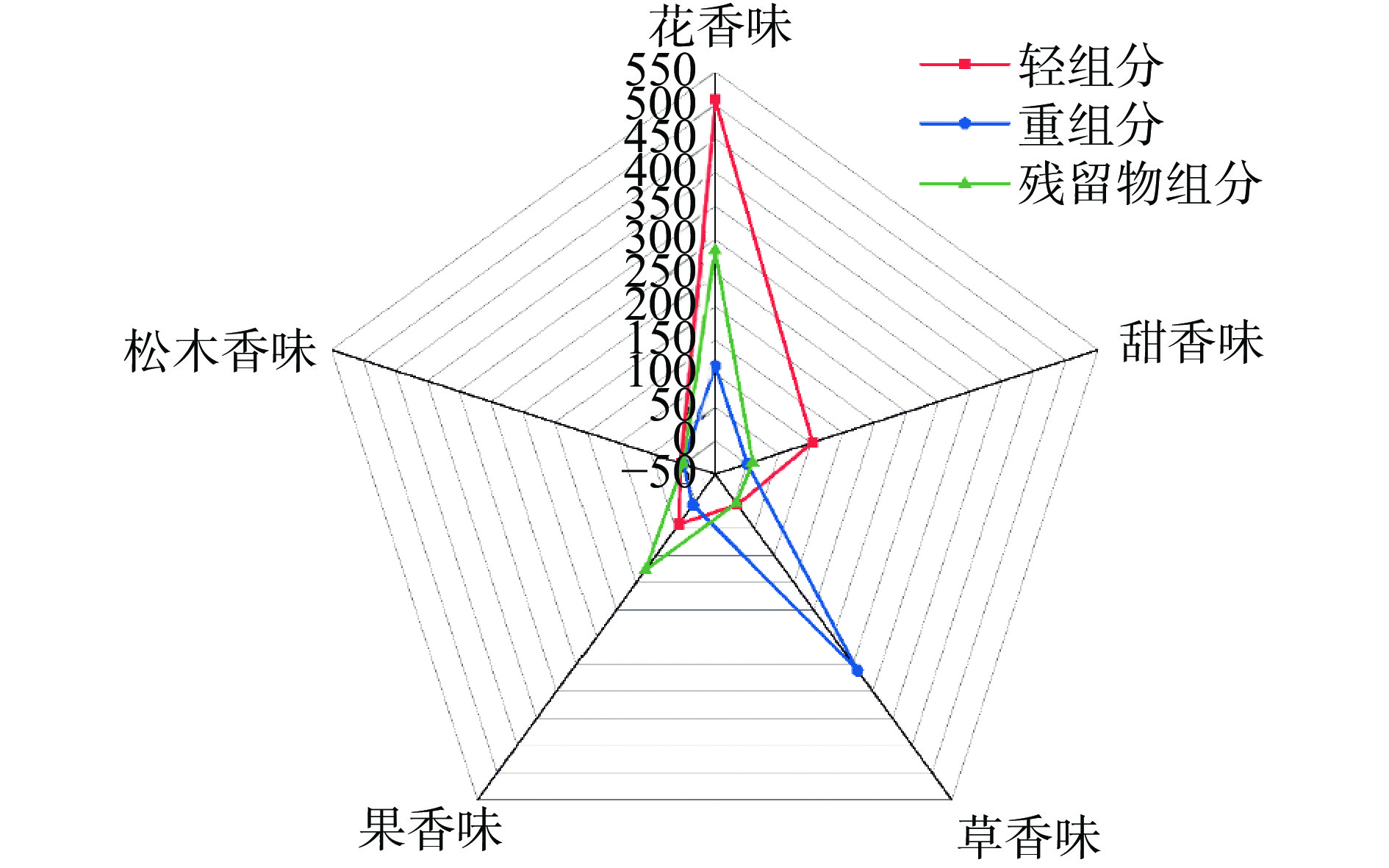Analysis of Volatile Components in the Molecular Distillation Fractions of Osmanthus fragrans Absolute by GC-MS Combined with Chemometrics Methods
-
摘要: 为了探究分子蒸馏技术纯化桂花净油的不同馏分挥发性成分与香气差异,采用气相色谱-质谱(Gas chromatography-mass spectrometry,GC-MS)结合化学计量学方法中的正交偏最小二乘判别分析法(Orthogonal partial least-squares discrimination analysis,OPLS-DA)、P-value与变量投影重要性(Variable important in the projection,VIP)与相对气味活度值(Relative odor activity value,ROAV)对桂花净油的轻组分、重组分和残留物组分挥发性成分进行分析。结果表明:三种馏分中共检测到8大类挥发性成分共73种,其中醇类22种、醛类5种、酸类10种、酚类3种、酮类5种、酯类17种、烷烃类5种、烯萜类6种。各馏分中醇类物质的种类与相对含量最高,是桂花净油挥发性成分的主要贡献物质,且各馏分的挥发性成分种类与相对含量具有显著性差异(P<0.05);建立的三种馏分挥发性成分判别模型,分类准确率为98.2%;并在分析确定出三种馏分27种差异性挥发物成分(VIP>1)后,对轻组分14种、重组分9种和残留物组分11种的关键香气贡献成分(ROAV>1)进行香气轮廓分析,轻组分与重组分、残留组分相比,表现出的花香味、甜味以及松木香味更为强烈。轻组分的挥发性成分种类与相对含量最多,香气特征中的桂花花香味最为浓郁强烈。本研究采用GC-MS结合化学计量学方法分析桂花净油各馏分挥发性成分差异与香气特征,为桂花净油分子蒸馏各馏分综合利用提供理论依据。Abstract: This study aimed to investigate the differences in volatile composition and aroma of different fractions of Osmanthus fragrans absolute purified by molecular distillation. Gas chromatography-mass spectrometry (GC-MS) combined with orthogonal partial least-squares discrimination analysis (OPLS-DA), P-value, variable importance in the projection (VIP), and relative odor activity value (ROAV) were used for analysis. The light, heavy, and residue fractions of Osmanthus fragrans absolute were analyzed. A total of 73 volatile components belonging to 8 major categories were detected in the three fractions, including 22 alcohols, 5 aldehydes, 10 acids, 3 phenols, 5 ketones, 17 esters, 5 alkanes, and 6 olefins. Alcohols were the main contributors to the volatile components in each fraction, and the types and relative contents of volatile components significantly differed among the fractions (P<0.05). The discrimination model achieved a classification accuracy of 98.2% for the volatile components of the three fractions. After analyzing and determining the 27 differential volatile components (VIP>1) of the three fractions, the key aroma contributing components (ROAV>1) of the 14 light fractions, 9 recombinant fractions, and 11 residue fractions were analyzed by the aroma profile analysis. Light fractions exhibited more intense floral, sweet, and pine woody aromas compared to recombinant and residue fractions. The light fractions had the highest types and relative contents of volatile components and showcased the most intense Osmanthus fragrans floral flavor. This study provided a theoretical basis for the comprehensive utilization of different fractions of Osmanthus fragrans absolute through molecular distillation using GC-MS combined with chemometrics methods.
-
桂花(Osmanthus fragrans Lour.)是我国传统名花之一,属木犀科木犀属植物[1],主要包括4个品种:金桂、银桂、丹桂和四季桂[2]。桂花净油是桂花经过提取获得具有独特香味的浸膏后,再使用乙醇对桂花浸膏脱除蜡质后得到的产品[3]。桂花净油具有改善睡眠、镇咳祛痰和提高免疫力等功效[2],是一种不能人工合成的高级天然香料[4−5]。桂花净油具有天然绿色、环保安全和可药食两用的特点,其需求量与应用范围不断增加[6],被广泛用于食品和医药等领域[7−8]。
现阶段桂花浸膏提取主要采用溶剂提取法[9−10]、超临界CO2萃取法[11]和亚临界流体萃取[12−13]等方法。溶剂提取法提取率较高,但提取纯度较低,溶剂残留难以除去[9−10];超临界CO2萃取技术所获取净油的蜡质含量较高[11]。亚临界萃取具有可较好地保留桂花中的天然组分,具有提取率与纯度较高的特点[12−13]。提取得到的桂花浸膏含有大量蜡质,因此需要对其进行分离纯化得到桂花净油。
分子蒸馏技术是一种在高真空条件下进行高效液-液分离纯化技术,该技术主要根据不同物质分子运动平均自由程的不同,从而对物质进行分离纯化[14−15]。对于桂花净油的分离纯化,分子蒸馏技术具有操作条件简单,适用于桂花净油这类热敏性强、易氧化物质的分离提取,其具有分离效率高等优点,在分离过程可有效降低杂质,保障提取物质不受污染,保持其原有品质[15]。目前分子蒸馏技术具有广阔的发展前景,已被广泛应用于香精香料提取[16−17]、油脂精炼[18]等领域。但采用分子蒸馏技术分离纯化桂花净油进行挥发性成分的相关研究鲜有报道。
因此,本文首先采用亚临界技术提取干桂花得到桂花浸膏,再采用分子蒸馏技术对脱蜡后的桂花净油进行分离纯化,并对各馏分物质进行气相色谱-质谱(Gas chromatography-mass spectrometry,GC-MS)分析,最后采用化学计量学方法建立桂花净油各馏分挥发性成分的判别模型与相对气味活度值(Relative odor activity value,ROAV)建立香气轮廓,评价各馏分差异性挥发性成分与香气特征。本研究将为分子蒸馏技术纯化桂花净油的馏分鉴别及综合利用提供理论依据。
1. 材料与方法
1.1 材料与仪器
咸宁金桂桂花 于2022年10月于湖北省咸宁市桂花种植基地采摘,共计100 kg,采后立即进行分选,剔除杂质后,在−4 ℃冷库进行预冷处理,冷链运输至实验室进行真空冷冻干燥处理后,20目粉碎,装入PE密封袋,置于干燥皿保存备用;正丁烷、石油醚、无水乙醇、无水硫酸钠 均为分析纯,国药集团化学试剂有限公司;正己烷 色谱级,德国默克Merck公司。
LGJ-25C 型冷冻干燥机 北京四环科学仪器厂有限公司;HBS-2500C高速粉碎机 东莞市华太电器有限公司;FC204电子天平 上海精密科学仪器有限公司;MS-QP2010Plus气相质谱联用仪 日本岛津公司;CBE-5L21-14亚临界提取设备 河南省亚临界生物技术公司;FMD-100刮膜式玻璃分子蒸馏器 江苏杜马司科学仪器有限公司;Avanti J26XP 型冷冻离心机 美国 Beckman 公司;SN-MS-H280D磁力搅拌器 上海尚普仪器设备有限公司;SN-R1005旋转蒸发仪 上海尚普仪器设备有限公司。
1.2 实验方法
1.2.1 桂花净油提取及纯化
准确称取1 kg干桂花,粉碎过20目筛后装入绢布袋,置于亚临界萃取设备萃取罐中,采用正丁烷进行提取,料液比1:25 g/mL,提取温度45 ℃,单次提取时间为30 min,萃取三次,减压蒸馏后得到萃取物;根据国标GB/T 14458-2013《香花浸膏检验方法》方法对桂花浸膏进行脱蜡处理后,在条件为−20 ℃,12000 r/min下进行冷冻离心分离蜡质后,得到桂花净油。采用分子蒸馏技术进行分离纯化,桂花净油样品置于主蒸发器中,刮膜式分子蒸馏器的参数条件调节至:蒸馏温度170 ℃,冷凝温度60 ℃,真空度17 Pa,刮膜转速300 r/min,待样品蒸馏完毕后,轻组分与重组分分别进入收集瓶中,残留组分由外置冷凝器与冷阱捕捉回收,最终得到桂花净油各馏出物。
1.2.2 桂花净油各馏分挥发性成分的GC-MS测定
取上述桂花净油各馏分样品10 g,用正己烷稀释并定容至10 mL,取1.5 mL的稀释液进行GC-MS分析。色谱条件:色谱柱HP-5MS(30 m×0.25 mm,0.25 μm);进样量1.0 μL;进样时间:2 min;载气He,柱流量1.05 mL/min,总流量9.3 mL/min;进样模式:不分流;进样温度250 ℃;柱箱温度:50 ℃;升温程序:起始温度50 ℃,保持1 min,以10 ℃/min速率升温至100 ℃,保持2 min;然后以5 ℃/min速率升温至230 ℃,保持20 min;再以5 ℃/min速率升温至300 ℃,保持20 min。
质谱条件:EI离子源;离子源温度:300 ℃;电子能量70 eV;发射电流:34.6 μA;扫描质量范围m/z 45~450。
定量定性分析:移取C7~C40正构烷烃混合标准品,用正己烷溶剂将其稀释为质量分数为1%的标准溶液,以液体进样的形式,按照上述方法条件进样分离,记录各成分保留时间。保留指数RI值(Retention index)根据 Kovats公式进行计算,如式(1)所示:
(1) 式中:RI为测量成分的保留指数;为待测挥发物的保留时间(min);n和n+1分别为正构烷烃的碳原子数;<<。
样品经过GC-MS分析得到的质谱数据与NIST 14标准谱库相匹配,计算各挥发性成分的保留指数并参考相关文献定性确定化合物,仅保留匹配度大于80%的成分,对其成分进行定性分析;采用各挥发性化合物峰面积占总峰面积比值表示相对含量计算各成分的相对百分含有量。
1.2.3 桂花净油各馏分挥发性成分的相对气味活度值计算
根据陈卓[19]与王赟等[20]的方法略作修改,采用ROAV对GC-MS所获取得到化合物的相对含量数据进行分析,计算公式如下:
(2) 式中:Ci为GC-MS数据通过峰面积归一化法计算获得化合物的相对含量(%);Ti为化合物i的在水中的香气阈值(mg/kg);Tmax为样品中对香气贡献最大成分的香气阈值(mg/kg);Cmax为对样品风味贡献最大成分的相对含量(%);当ROAV>1时,说明该香气成分为此样品的关键香气贡献成分。
1.3 数据处理
实验重复3次,GC-MS分析得到的质谱数据与NIST 14标准谱库相匹配,最终以各挥发性化合物峰面积占总峰面积比值表示相对含量。数据使用Excel 2010软件进行统计;GC-MS数据均以(平均值±标准差)表示;使用SPSS 16.0软件对GC-MS数据获取的挥发性成分数据进行方差分析和Duncan法多重比较,P<0.05表示显著;使用Orgrin 2023b软件绘制韦恩图、聚类热图与PCA图;采用SIMCA软件绘制OPLS-DA图。
2. 结果与分析
2.1 GC-MS 检测结果分析
采用GC-MS对桂花净油分子蒸馏后得到三种馏分的挥发性成分进行检测,以峰面积法计算其相对含量,如表1所示,共检测到8大类挥发性成分73种,其中醇类22种、醛类5种、酸类10种、酚类3种、酮类5种、酯类17种、烷烃类5种、烯萜类6种。
表 1 桂花净油各馏分的挥发性成分种类及相对含量Table 1. Types and relative contents of volatile components in different fractions of Osmanthus fragrans absolute序号 化合物名称 保留时间(min) 保留指数值(RI) 相对含量(%) 匹配度(%) 实验值 参考值 轻组分 重组分 残留物组分 X1 氧化芳樟醇 13.20 1176 1420 2.86±0.44b 0.32±0.37c 6.76±2.70a 82 X2 芳樟醇 8.18 1097 1537 3.98±1.62 − − 81 X3 反式氧化芳樟醇 7.94 1067 1150 0.14±0.02b 0.22±0.06b 12.22±2.31a 90 X4 丙基环己醇 8.29 1167 1138 0.22±0.02 − − 84 X5 2,6-二甲基-3,7-辛二烯-2,6-二醇 10.66 1197 1191 0.83±0.08a 0.05±0.01b − 91 X6 香叶醇 12.29 1228 1276 0.57±0.04a 0.49±0.18a − 96 X7 4-甲氧基苯乙醇 15.55 1325 1374 1.91±0.11a 0.93±0.16b − 82 X8 植物醇 31.74 2106 2111 0.39±0.16a 0.09±0.04b − 86 X9 菜油甾醇 66.39 2632 3114 1.01±0.02 − − 85 X10 植物甾醇 68.19 2731 3148 1.12±0.42 − − 83 X11 羊毛甾醇 69.73 3326 3300 0.47±0.04 − − 85 X12 24-亚甲基环阿屯醇 70.60 2834 3108 0.73±0.05b 1.51±0.44a − 92 X13 对羟基苯乙醇 16.91 1356 1431 − 1.10±0.16 85 X14 二氢-β-紫罗兰醇 17.60 1449 1723 2.84±0.50 − 92 X15 二十六碳醇 42.38 2848 2852 − 0.35±0.29 − 93 X16 豆甾醇 69.11 3225 3148 4.71±0.58b 10.73±4.13a − 85 X17 γ-谷甾醇 68.16 3290 3351 − 5.49±1.74 − 84 X18 乌发醇 75.27 3638 3692 − 0.59±0.27 − 80 X19 香叶基香叶醇 78.39 2192 2201 − 0.20±0.02 − 86 X20 1-己醇 4.17 1138 1360 − − 0.07±0.01 93 X21 α-松油醇 11.29 1143 1646 − − 7.22±6.62 81 X22 库贝醇 15.09 1131 1352 − − 1.14±0.09 81 醇类 21.46±1.47b 22.62±6.22b 30.75±6.44a X23 正十五醛 23.59 1701 2059 0.33±0.11 − − 83 X24 熊果醛 74.40 3611 3615 0.20±0.03ab 0.61±0.46a − 94 X25 壬醛 8.28 1101 1105 − 0.23±0.07 − 95 X26 正十六醛 31.72 1811 1820 − 0.13±0.06 − 82 X27 辛醛 6.11 1701 1096 − − 0.20±0.09 93 醛类 0.53±0.11b 0.97±0.39a 0.20±0.09c X28 正癸酸 16.53 1005 1464 0.98±0.03a 0.06±0.02b − 85 X29 2-甲基-3-丁烯酸 24.30 1372 1027 2.10±0.03 − − 89 X30 肉豆蔻酸 24.88 1091 1763 0.48±0.07b 1.03±0.14a − 94 X31 棕榈酸 30.17 1755 1961 5.09±4.40a 5.26±2.18a 0.89±0.11b 95 X32 花生酸 36.96 1968 2380 0.84±0.21a 0.71±0.06a − 81 X33 α-亚麻酸 33.54 2366 2086 9.52±0.08a 6.27±0.06b − 88 X34 2-羟基十六烷酸 40.77 2201 2519 1.12±0.11 − − 86 X35 棕榈油酸 28.33 2498 1941 − 0.37±0.09 − 80 X36 硬脂酸 32.73 1976 2172 − 2.03±0.24a 0.08±0.01b 85 X37 二十烯酸 35.73 2167 2365 − 0.53±0.04 − 82 酸类 20.14±4.96a 16.44±2.46b 0.98±0.11c X38 2,4-二叔丁基苯酚 19.09 1555 1513 0.08±0.01a 0.09±0.03a − 85 X39 生育酚 65.04 3114 3142 1.75±0.34b 3.27±0.11a − 89 X40 甲基丁香酚 16.62 1361 1402 1.66±1.03 − − 94 酚类 3.48±0.342a 3.36±0.136a 0.00b X41 蒿酮 17.57 1068 1061 0.75±0.06 − − 82 X42 β-紫罗兰酮 18.55 1457 1486 0.80±0.08a 0.18±0.03b − 88 X43 植酮 26.44 1754 1844 0.67±0.05a 0.26±0.02b 0.24±0.07b 95 X44 二氢-β-紫罗兰酮 60.15 1449 2106 3.31±0.22a 2.48±0.58a 2.70±0.29a 81 X45 反式-3-壬烯-2-酮 9.37 1060 1114 − − 2.18±1.90 81 酮类 5.53±0.35a 2.86±0.59b 5.11±2.13a X46 香叶酸甲酯 16.36 1342 1319 0.32±0.02 − − 90 X47 γ-癸内酯 18.29 1383 1463 1.81±0.13b 0.49±0.04c 3.59±0.17a 93 X48 二氢猕猴桃内酯 19.65 1426 1479 0.34±0.02b − 1.29±0.86a 92 X49 对羟基苯乙酸乙酯 20.63 1559 1559 0.50±0.05b 0.83±0.15a − 85 X50 肉豆蔻酸甲酯 23.85 1680 1820 0.46±0.04a − 0.45±0.16a 87 X51 棕榈酸甲酯 28.07 1978 1927 0.82±0.11b 2.34±3.19a 0.95±0.04a 93 X52 反-9-十八碳烯酸甲酯 31.47 2085 2084 0.85±0.05 − − 94 X53 亚麻酸乙酯 32.71 2201 2173 3.32±0.05 − − 90 X54 油醇乙酸酯 45.94 2185 − 0.41±0.03 − − 90 X55 硬脂酸苯酯 58.74 2651 − 2.84±0.40 − − 83 X56 三癸酸甘油酯 71.93 3739 3503 0.48±0.04b 3.24±0.25a − 93 X57 甘油三酯 76.64 4336 − 0.08±0.01b 1.09±0.10a − 80 X58 9,12-十八烯酸丁酯 47.98 2391 − − 4.29±0.45 − 80 X59 花生四烯酸甲酯 48.63 2308 2231 − 3.16±0.10 − 86 X60 磷酸三异丙基酯 11.78 1005 1182 − − 6.61±0.21 81 X61 苯甲酸苄酯 17.91 1579 1712 − − 3.05±0.12 80 X62 油酸甲酯 31.35 2089 2072 − − 1.12±0.02 92 酯类 12.23±0.66c 15.45±3.66b 17.21±0.10a X63 正十四烷 16.06 1395 1400 0.24±0.13b 0.26±0.21b 3.13±0.27a 90 X64 正十五烷 18.88 1495 1500 − − 3.80±0.24a 91 X65 正十六烷 21.00 1495 1600 0.41±0.15a 0.15±0.11a 1.46±1.53a 90 X66 正十七烷 23.27 1694 1700 0.86±0.36a 0.11±0.02b − 93 X67 正二十一烷 35.12 1993 2100 1.21±0.90a 0.28±0.03b − 92 烷烃类 2.72±0.99b 0.79±0.16c 8.39±1.76a X68 石竹烯 16.71 1494 1427 1.59±0.52b 0.14±0.05c 3.40±2.03a 94 X69 1-十九烯 34.55 1900 1900 0.21±0.11 − − 93 X70 角鲨烯 56.84 2821 2822 3.98±0.47a 3.08±0.27b − 94 X71 1-二十七烷烯 46.94 2664 2694 − 2.50±0.06 − 87 X72 β-月桂烯 5.93 988 990 − − 0.24±0.05 89 X73 α-蒎烯 15.76 1221 930 2.67±0.71 − − 83 烯萜类 8.45±0.24a 5.72±0.25b 3.64±2.71c 注:表中数据以平均值±标准差表示;−表示未检出;同行不同小写字母表示差异显著(P<0.05);RI实验值通过实验结果计算获得,RI参考值通过 http://webbook.nist.gov/chemistry/ 搜索查询获取。 如图1(a)所示,在经分子蒸馏得到的桂花净油轻组分、重组分和残留物组分中,分别鉴定出50、43和24种化合物,其中三种馏分共有成分有11种,轻组分和重组分共有成分有30种,轻组分和残留物组分共有成分有13种,重组分和残留物组分共有成分有12种。在桂花净油分子蒸馏的轻组分、重组分和残留物组分中检测到18种、12种、10种独有成分。韦恩图显示了桂花净油各馏分的挥发性成分种类具有显著差异(P<0.05)。
如图1(b)所示,在桂花净油各馏分中,醇类物质种类与相对含量最高,是桂花净油挥发性成分的主要贡献物质。轻组分含有14种醇类物质,相对含量为21.46%;重组分含有13种醇类物质,相对含量为22.62%;残留物组分含有5种醇类物质,相对含量为30.75%,各馏分之间具有显著差异(P<0.05)。桂花中芳香活性化合物具有典型的甜桂花的花香和甜味[21−24],包括芳樟醇、反式氧化芳樟醇、氧化芳樟醇、4-甲氧基苯乙醇、二氢-β-紫罗兰醇。其中芳樟醇在轻组分中相对含量最高为3.98%,反式氧化芳樟醇在残留物组分中相对含量最高为12.22%,氧化芳樟醇在残留物组分中相对含量最高为6.76%,4-甲氧基苯乙醇在轻组分中相对含量最高为1.91%,二氢-β-紫罗兰醇在轻组分中相对含量最高为2.84%。醛类物质的种类与相对含量较少,共鉴定出5种醛类物质,除熊果醛为轻组分与重组分共有物质外,正十五醛为轻组分独有成分,壬醛与正十六醛为重组分独有成分,辛醛为残留物组分独有成分,醛类物质为桂花净油挥发性香气贡献了草本植物的清香与甜果香味[25]。三种馏分的酸类物质相对含量具有显著性差异(P<0.05),轻组分相对含量最高为20.14%,其中α-亚麻酸,花生酸等为人体必需营养物质,具有一定保健功能。酮类和酚类物质在桂花净油的三种馏分中种类与相对含量较少,其中β-紫罗兰酮为轻组分与重组分共有成分,具有清新花香味[26],轻组分中的相对含量最高为0.80%;二氢-β-紫罗兰酮为三种馏分共有成分,具有清新花香味[27],轻组分中的相对含量最高为3.31%;维生素E和2,4-二叔丁基苯酚是轻组分与重组分的共有成分,甲基丁香酚是轻组分的独有成分,具有丁香-茴香香气。酯类物质是芳香族化合物的主要类型,决定了桂花的浓郁而独特香味[28]。三种馏分共鉴出17种酯类物质,轻组分12种,重组分7种,残留物组分7种;三种馏分的长链酯相对含量差异较小,轻组分为12.23%,重组分为15.45%,残留物组分为17.21%。残留物组分中磷酸三异丙基酯含量最高为6.61%,而肉豆蔻酸甲酯、二氢猕猴桃内酯等具有清新甜果香味与花香味的物质,三者并未共有,这可能是导致各馏分之间挥发性香气差异的因素之一[29]。烷烃类物质的感官阈值较高,对桂花净油各馏分的挥发性香气贡献较小,具有定香的作用[30]。烯萜类物质挥发性强,其相对含量与种类较多,石竹烯、β-月桂烯、α-蒎烯是桂花净油各馏分挥发性香气的主要成分[31],且各馏分之间差异显著(P<0.05)。
2.2 桂花净油各馏分的挥发性成分OPLS-DA模型分析
正交偏最小二乘判别分析(Orthogonal partial least-squares discrimination analysis,OPLS-DA)是一种有监督的判别统计方法,可实现对数据进行归一化降维处理,从达到对复杂实验数据可视化及预测判别分析[32−33]。为了更好的对桂花净油的馏分进行区分,通过对表1中桂花净油各馏分的GC-MS数据进行OPLS-DA模型分析,结果如图2所示。三种馏分挥发性成分在得分图(见图2(a))中实现了馏分种类区分,自变量拟合指数(R2x)为0.900,因变量拟合指数(R2y)为0.994,模型预测指数(Q2)为0.982,对于桂花净油馏分区分的预测率为98.2%。其中轻组分均匀分布在第一象限,残留物组分分布在第二、三象限,重组分均匀分布在第四象限,表明桂花净油不同馏分的挥发性成分存在一定差异。
如图2(b)所示,对桂花净油各馏分的GC-MS数据建立OPLS-DA模型,进行200次响应的置换检验,以验证建立的OPLS-DA模型是否出现过拟合现象[34−35]。置换检验得到R2=0.639,Q2=−0.796,所有左侧的Q2大于右侧,Q2与Y轴的截距为负值,且R2和Q2的回归线的斜率均大于1,说明该模型未出现拟合现象,具有较好的稳定性和预测能力。
2.3 桂花净油各馏分的差异挥发性成分筛选
变量投影重要性(Variable important in the projection,VIP)可用于筛选出对分子蒸馏后的桂花净油挥发性成分中有重要贡献的物质成分,VIP值越大,说明对样品组间区分的贡献率越大,组间差异越显著[34]。通过对表1中桂花净油各馏分的GC-MS数据进行VIP值的筛选,结果由图3可知,VIP值大于1的桂花净油挥发性物质共27种,分别为反式氧化芳樟醇、豆甾醇、α-亚麻酸、α-松油醇、γ-谷甾醇、磷酸三异丙基酯、9,12-十八烯酸丁酯、氧化芳樟醇、芳樟醇、亚麻酸乙酯、5,11,14,17-二十碳四烯酸甲酯、正十五烷、角鲨烯、三癸酸甘油酯、γ-癸内酯、硬脂酸苯酯、棕榈酸、二氢-β-紫罗兰醇、α-蒎烯、苯甲酸苄酯、1-二十七烷烯、生育酚、正十四烷、香叶醇、2-甲基-3-丁烯酸、石竹烯、硬脂酸。
为了进一步分析不同挥发性成分对区分桂花净油各馏分的贡献率,根据P<0.05且VIP>1的标准,对图3中筛选出的27种不同馏分的特征挥发性物质GC-MS数据进行聚类热图分析,如图4所示,其中醇类8种、酸类4种、酚类1种、酯类8种、烯萜类6种。根据聚类热图中挥发性成分的颜色由绿色至红色,代表其相对含量由高到低,筛选出轻组分含量较突出的11种挥发性成分,包括α-亚麻酸、豆甾醇、棕榈酸等;重组分较高含量的10种挥发性成分,包括豆甾醇、γ-谷甾醇、棕榈酸等;残留物组分较高含量的9种挥发性成分,包括反式氧化芳樟醇、氧化芳樟醇、α-松油醇等。
2.4 桂花净油各馏分挥发性成分的ROAV分析与香气轮廓分析
为了说明桂花净油各馏分挥发性成分的香气特征,本研究通过根据1.2.3方法对桂花净油各馏分挥发性成分进行ROAV值的计算分析,结果如表2所示,轻组分、重组分和残留物组分的关键香气贡献成分(ROAV>1)分别为14种、9种和11种,在轻组分的挥发性成分中氧化芳樟醇、芳樟醇、香叶醇、二氢-β-紫罗兰醇、正十五醛、熊果醛、甲基丁香酚、β-紫罗兰酮、二氢-β-紫罗兰酮、γ-癸内酯、二氢猕猴桃内酯、肉豆蔻酸甲酯、石竹烯、α-蒎烯,是其关键香气贡献成分(ROAV>1),为样品贡献了花香味、果香味、草香味、甜味与松木香味;在重组分的挥发性成分中氧化芳樟醇、香叶醇、香叶基香叶醇、熊果醛、壬醛、正十六醛、β-紫罗兰酮、二氢-β-紫罗兰酮、γ-癸内酯是其关键香气贡献成分(ROAV>1),为样品贡献了花香味、草香味与甜桃果香味;在残留组分的挥发性成分中氧化芳樟醇、反式氧化芳樟醇、香叶醇、α-松油醇、库贝醇、二氢-β-紫罗兰酮、γ-癸内酯、二氢猕猴桃内酯、肉豆蔻酸甲酯、石竹烯、β-月桂烯是其关键香气贡献成分(ROAV>1),为样品贡献了花香味、甜香味与甜桃果香味。
表 2 桂花净油各馏分挥发性成分的ROAV值Table 2. ROAV values of volatile components of different fractions of Osmanthus fragrans absolute挥发性成分 气味阈值(mg/kg) 香气描述 ROAV 轻组分 重组分 残留物组分 氧化芳樟醇 0.077 花香味 2.271 1.149 10.240 芳樟醇 0.00108 花香味 207.294 − − 反式氧化芳樟醇 0.058 花香味 0.151 0.387 24.568 香叶醇 0.0075 玫瑰花香味 4.626 6.671 51.710 4-甲氧基苯乙醇 0.482 花香味 0.243 0.197 − 二氢-β-紫罗兰醇 0.0029 紫罗兰花香味 59.958 − − 香叶基香叶醇 0.002 玫瑰花香味 − 10.211 − 1-己醇 2.5 果香味 − − 0.003 α-松油醇 0.01 白兰花香味 − − 84.210 库贝醇 0.04 浓郁、辛呛、香甜的草香味 − − 3.332 正十五醛 0.0002 甜味 100.000 − − 熊果醛 0.002 草香味 6.224 31.315 − 壬醛 0.0031 草香味 − 7.466 − 正十六醛 0.00005 草香味 − 272.300 − 辛醛 0.17 草香味 − − 0.137 甲基丁香酚 0.00071 丁香-茴香花香味 142.857 − − β-紫罗兰酮 0.0025 花香味 19.673 7.488 − 二氢-β-紫罗兰酮 0.0029 花香味 69.880 85.211 108.406 γ-癸内酯 0.0079 甜桃果香味 27.822 6.334 26.661 二氢猕猴桃内酯 0.0015 果香味 13.741 − 100.000 肉豆蔻酸甲酯 0.02 甜味和花香味 1.418 − 2.604 石竹烯 0.064 甜香味 1.524 0.229 6.193 β-月桂烯 0.013 天竺葵花香味 − − 2.152 α-蒎烯 0.042 松木香味 3.897 − − 注:−为未检出,特征香气的香气阈值来自文献[24,36],香气描述来源于https://www.femaflavor.org/flavor-library/网站。 本研究通过将表2所示的桂花净油各馏分同类香气属性的关键香气贡献成分(ROAV>1)ROAV值相加后,构建桂花净油各馏分挥发性成分的香气轮廓描述雷达图,如图5所示,花香味在桂花净油轻组分挥发性成分的中香气程度最高,ROAV值为508.371;草香味在桂花净油重组分挥发性成分的中香气程度最高,ROAV值为312.230;果香味在残留物组分的挥发性成分中香气程度最高,ROAV值为126.661。
3. 结论
本研究以咸宁金桂为原料,采用分子蒸馏技术对亚临界萃取并脱蜡获得的桂花净油进行纯化分离后,得到轻组分、重组分、残留物组分三种不同馏分,采用GC-MS技术对其进行挥发性成分分析,结果表明桂花净油各馏分在种类与相对含量上差异显著(P<0.05),且具有明显的特征区分。桂花净油各馏分中共检测出73种挥发性成分,其中各馏分的特征性挥发性成分主要以醇类、酸类、酯类、酮类化合物为主。通过OPLS-DA模型分析,桂花净油的轻组分、重组分与残留物组分的挥发性成分之间存在着明显区分,可验证模型具有较好的稳定性与预测性。基于P-value与VIP值,对桂花净油各馏分挥发性品质相关的物质进行筛选,得到27种相对含量差异显著的挥发性成分后,通过聚类分析可知各馏分中含量突出的挥发性成分种类分别有轻组分11种、重组分10种、残留物组分9种,最后采用ROAV分析与香气轮廓分析对各馏分挥发性成分进行了整体香气描述,轻组分表现出的花香味、甜味以及松木香味最为浓郁强烈。本研究对经分子蒸馏技术纯化分离后桂花净油的各馏分进行了挥发性成分分析,为桂花净油的各馏分挥发性成分鉴别、香气品质分析以及综合利用提供理论参考。
-
表 1 桂花净油各馏分的挥发性成分种类及相对含量
Table 1 Types and relative contents of volatile components in different fractions of Osmanthus fragrans absolute
序号 化合物名称 保留时间(min) 保留指数值(RI) 相对含量(%) 匹配度(%) 实验值 参考值 轻组分 重组分 残留物组分 X1 氧化芳樟醇 13.20 1176 1420 2.86±0.44b 0.32±0.37c 6.76±2.70a 82 X2 芳樟醇 8.18 1097 1537 3.98±1.62 − − 81 X3 反式氧化芳樟醇 7.94 1067 1150 0.14±0.02b 0.22±0.06b 12.22±2.31a 90 X4 丙基环己醇 8.29 1167 1138 0.22±0.02 − − 84 X5 2,6-二甲基-3,7-辛二烯-2,6-二醇 10.66 1197 1191 0.83±0.08a 0.05±0.01b − 91 X6 香叶醇 12.29 1228 1276 0.57±0.04a 0.49±0.18a − 96 X7 4-甲氧基苯乙醇 15.55 1325 1374 1.91±0.11a 0.93±0.16b − 82 X8 植物醇 31.74 2106 2111 0.39±0.16a 0.09±0.04b − 86 X9 菜油甾醇 66.39 2632 3114 1.01±0.02 − − 85 X10 植物甾醇 68.19 2731 3148 1.12±0.42 − − 83 X11 羊毛甾醇 69.73 3326 3300 0.47±0.04 − − 85 X12 24-亚甲基环阿屯醇 70.60 2834 3108 0.73±0.05b 1.51±0.44a − 92 X13 对羟基苯乙醇 16.91 1356 1431 − 1.10±0.16 85 X14 二氢-β-紫罗兰醇 17.60 1449 1723 2.84±0.50 − 92 X15 二十六碳醇 42.38 2848 2852 − 0.35±0.29 − 93 X16 豆甾醇 69.11 3225 3148 4.71±0.58b 10.73±4.13a − 85 X17 γ-谷甾醇 68.16 3290 3351 − 5.49±1.74 − 84 X18 乌发醇 75.27 3638 3692 − 0.59±0.27 − 80 X19 香叶基香叶醇 78.39 2192 2201 − 0.20±0.02 − 86 X20 1-己醇 4.17 1138 1360 − − 0.07±0.01 93 X21 α-松油醇 11.29 1143 1646 − − 7.22±6.62 81 X22 库贝醇 15.09 1131 1352 − − 1.14±0.09 81 醇类 21.46±1.47b 22.62±6.22b 30.75±6.44a X23 正十五醛 23.59 1701 2059 0.33±0.11 − − 83 X24 熊果醛 74.40 3611 3615 0.20±0.03ab 0.61±0.46a − 94 X25 壬醛 8.28 1101 1105 − 0.23±0.07 − 95 X26 正十六醛 31.72 1811 1820 − 0.13±0.06 − 82 X27 辛醛 6.11 1701 1096 − − 0.20±0.09 93 醛类 0.53±0.11b 0.97±0.39a 0.20±0.09c X28 正癸酸 16.53 1005 1464 0.98±0.03a 0.06±0.02b − 85 X29 2-甲基-3-丁烯酸 24.30 1372 1027 2.10±0.03 − − 89 X30 肉豆蔻酸 24.88 1091 1763 0.48±0.07b 1.03±0.14a − 94 X31 棕榈酸 30.17 1755 1961 5.09±4.40a 5.26±2.18a 0.89±0.11b 95 X32 花生酸 36.96 1968 2380 0.84±0.21a 0.71±0.06a − 81 X33 α-亚麻酸 33.54 2366 2086 9.52±0.08a 6.27±0.06b − 88 X34 2-羟基十六烷酸 40.77 2201 2519 1.12±0.11 − − 86 X35 棕榈油酸 28.33 2498 1941 − 0.37±0.09 − 80 X36 硬脂酸 32.73 1976 2172 − 2.03±0.24a 0.08±0.01b 85 X37 二十烯酸 35.73 2167 2365 − 0.53±0.04 − 82 酸类 20.14±4.96a 16.44±2.46b 0.98±0.11c X38 2,4-二叔丁基苯酚 19.09 1555 1513 0.08±0.01a 0.09±0.03a − 85 X39 生育酚 65.04 3114 3142 1.75±0.34b 3.27±0.11a − 89 X40 甲基丁香酚 16.62 1361 1402 1.66±1.03 − − 94 酚类 3.48±0.342a 3.36±0.136a 0.00b X41 蒿酮 17.57 1068 1061 0.75±0.06 − − 82 X42 β-紫罗兰酮 18.55 1457 1486 0.80±0.08a 0.18±0.03b − 88 X43 植酮 26.44 1754 1844 0.67±0.05a 0.26±0.02b 0.24±0.07b 95 X44 二氢-β-紫罗兰酮 60.15 1449 2106 3.31±0.22a 2.48±0.58a 2.70±0.29a 81 X45 反式-3-壬烯-2-酮 9.37 1060 1114 − − 2.18±1.90 81 酮类 5.53±0.35a 2.86±0.59b 5.11±2.13a X46 香叶酸甲酯 16.36 1342 1319 0.32±0.02 − − 90 X47 γ-癸内酯 18.29 1383 1463 1.81±0.13b 0.49±0.04c 3.59±0.17a 93 X48 二氢猕猴桃内酯 19.65 1426 1479 0.34±0.02b − 1.29±0.86a 92 X49 对羟基苯乙酸乙酯 20.63 1559 1559 0.50±0.05b 0.83±0.15a − 85 X50 肉豆蔻酸甲酯 23.85 1680 1820 0.46±0.04a − 0.45±0.16a 87 X51 棕榈酸甲酯 28.07 1978 1927 0.82±0.11b 2.34±3.19a 0.95±0.04a 93 X52 反-9-十八碳烯酸甲酯 31.47 2085 2084 0.85±0.05 − − 94 X53 亚麻酸乙酯 32.71 2201 2173 3.32±0.05 − − 90 X54 油醇乙酸酯 45.94 2185 − 0.41±0.03 − − 90 X55 硬脂酸苯酯 58.74 2651 − 2.84±0.40 − − 83 X56 三癸酸甘油酯 71.93 3739 3503 0.48±0.04b 3.24±0.25a − 93 X57 甘油三酯 76.64 4336 − 0.08±0.01b 1.09±0.10a − 80 X58 9,12-十八烯酸丁酯 47.98 2391 − − 4.29±0.45 − 80 X59 花生四烯酸甲酯 48.63 2308 2231 − 3.16±0.10 − 86 X60 磷酸三异丙基酯 11.78 1005 1182 − − 6.61±0.21 81 X61 苯甲酸苄酯 17.91 1579 1712 − − 3.05±0.12 80 X62 油酸甲酯 31.35 2089 2072 − − 1.12±0.02 92 酯类 12.23±0.66c 15.45±3.66b 17.21±0.10a X63 正十四烷 16.06 1395 1400 0.24±0.13b 0.26±0.21b 3.13±0.27a 90 X64 正十五烷 18.88 1495 1500 − − 3.80±0.24a 91 X65 正十六烷 21.00 1495 1600 0.41±0.15a 0.15±0.11a 1.46±1.53a 90 X66 正十七烷 23.27 1694 1700 0.86±0.36a 0.11±0.02b − 93 X67 正二十一烷 35.12 1993 2100 1.21±0.90a 0.28±0.03b − 92 烷烃类 2.72±0.99b 0.79±0.16c 8.39±1.76a X68 石竹烯 16.71 1494 1427 1.59±0.52b 0.14±0.05c 3.40±2.03a 94 X69 1-十九烯 34.55 1900 1900 0.21±0.11 − − 93 X70 角鲨烯 56.84 2821 2822 3.98±0.47a 3.08±0.27b − 94 X71 1-二十七烷烯 46.94 2664 2694 − 2.50±0.06 − 87 X72 β-月桂烯 5.93 988 990 − − 0.24±0.05 89 X73 α-蒎烯 15.76 1221 930 2.67±0.71 − − 83 烯萜类 8.45±0.24a 5.72±0.25b 3.64±2.71c 注:表中数据以平均值±标准差表示;−表示未检出;同行不同小写字母表示差异显著(P<0.05);RI实验值通过实验结果计算获得,RI参考值通过 http://webbook.nist.gov/chemistry/ 搜索查询获取。 表 2 桂花净油各馏分挥发性成分的ROAV值
Table 2 ROAV values of volatile components of different fractions of Osmanthus fragrans absolute
挥发性成分 气味阈值(mg/kg) 香气描述 ROAV 轻组分 重组分 残留物组分 氧化芳樟醇 0.077 花香味 2.271 1.149 10.240 芳樟醇 0.00108 花香味 207.294 − − 反式氧化芳樟醇 0.058 花香味 0.151 0.387 24.568 香叶醇 0.0075 玫瑰花香味 4.626 6.671 51.710 4-甲氧基苯乙醇 0.482 花香味 0.243 0.197 − 二氢-β-紫罗兰醇 0.0029 紫罗兰花香味 59.958 − − 香叶基香叶醇 0.002 玫瑰花香味 − 10.211 − 1-己醇 2.5 果香味 − − 0.003 α-松油醇 0.01 白兰花香味 − − 84.210 库贝醇 0.04 浓郁、辛呛、香甜的草香味 − − 3.332 正十五醛 0.0002 甜味 100.000 − − 熊果醛 0.002 草香味 6.224 31.315 − 壬醛 0.0031 草香味 − 7.466 − 正十六醛 0.00005 草香味 − 272.300 − 辛醛 0.17 草香味 − − 0.137 甲基丁香酚 0.00071 丁香-茴香花香味 142.857 − − β-紫罗兰酮 0.0025 花香味 19.673 7.488 − 二氢-β-紫罗兰酮 0.0029 花香味 69.880 85.211 108.406 γ-癸内酯 0.0079 甜桃果香味 27.822 6.334 26.661 二氢猕猴桃内酯 0.0015 果香味 13.741 − 100.000 肉豆蔻酸甲酯 0.02 甜味和花香味 1.418 − 2.604 石竹烯 0.064 甜香味 1.524 0.229 6.193 β-月桂烯 0.013 天竺葵花香味 − − 2.152 α-蒎烯 0.042 松木香味 3.897 − − 注:−为未检出,特征香气的香气阈值来自文献[24,36],香气描述来源于https://www.femaflavor.org/flavor-library/网站。 -
[1] 陈柏楠, 杨豪, 包韫辉, 等. 不同工艺真空冷冻干燥桂花的品质比较分析[J]. 现代食品科技,2021,37(2):205−212,307. [CHEN B N, YANG H, BAO Y H, et al. Comparative analysis of different vacuum freeze drying processes on quality of Osmanthus fragrans[J]. Modern Food Science and Technology,2021,37(2):205−212,307.] CHEN B N, YANG H, BAO Y H, et al . Comparative analysis of different vacuum freeze drying processes on quality of Osmanthus fragrans[J]. Modern Food Science and Technology,2021 ,37 (2 ):205 −212,307 .[2] 李红领, 李春阳, 曾晓雄, 等. 桂花酶解物中酚类物质及其抗氧化活性研究[J]. 食品工业科技,2015,36(24):85−90. [LI Hongling, LI Chunyang, ZENG Xiaoxiong, et al. Study on the phenolics of hydrolysates from Osmanthus fragrans Lour and its antioxidant activity[J]. Science and Technology of Food Industry,2015,36(24):85−90.] LI Hongling, LI Chunyang, ZENG Xiaoxiong, et al . Study on the phenolics of hydrolysates from Osmanthus fragrans Lour and its antioxidant activity[J]. Science and Technology of Food Industry,2015 ,36 (24 ):85 −90 .[3] 李焕威. 在线裂解-冷肼捕集-气相色谱/质谱联用法分析桂花净油热裂解挥发性成分[J]. 分析仪器,2019,223(2):43−50. [LI Huanwei. Analysis of pyrolytic volatile constituents of Osmanthus absolute oil by online pyrolysis-cold trapping coupled with gas chromatography-mass spectrometry[J]. Analytical Instrumentation,2019,223(2):43−50.] doi: 10.3969/j.issn.1001-232x.2019.02.008 LI Huanwei . Analysis of pyrolytic volatile constituents of Osmanthus absolute oil by online pyrolysis-cold trapping coupled with gas chromatography-mass spectrometry[J]. Analytical Instrumentation,2019 ,223 (2 ):43 −50 . doi: 10.3969/j.issn.1001-232x.2019.02.008[4] 张雪松, 裴建军, 赵林果, 等. 不同品种桂花转录组分析及桂花精油成分差异的初步探讨[J]. 天然产物研究与开发,2016,28(4):529−535. [ZHANG Xuesong, PEI Jianjun, ZHAO Linguo, et al. Transcriptome analysis of different Osmanthus reveals insight into the difference of Osmanthus oil components[J]. Natural Product Research and Development,2016,28(4):529−535.] ZHANG Xuesong, PEI Jianjun, ZHAO Linguo, et al . Transcriptome analysis of different Osmanthus reveals insight into the difference of Osmanthus oil components[J]. Natural Product Research and Development,2016 ,28 (4 ):529 −535 .[5] 周姚红, 李毅康, 狄一博, 等. 桂花精油的提取及成分分析[J]. 广州化工,2019,47(22):105−106,113. [ZHOU Yaohong, LI Yikang, DI Yibo, et al. Extraction and components analysis of Osmanthus fragrans essential oil[J]. Guangzhou Chemical Industry,2019,47(22):105−106,113.] ZHOU Yaohong, LI Yikang, DI Yibo, et al . Extraction and components analysis of Osmanthus fragrans essential oil[J]. Guangzhou Chemical Industry,2019 ,47 (22 ):105 −106,113 .[6] 郑义, 朱玲昱, 丁宁, 等. 桂花精油提取工艺及其成分分析[J]. 江苏农业科学,2017,45(23):188−191. [ZHENG Yi, ZHU Lingyu, DING Ning, et al. Extraction process of Osmanthus essential oil and its composition analysis[J]. Jiangsu Agricultural Sciences,2017,45(23):188−191.] ZHENG Yi, ZHU Lingyu, DING Ning, et al . Extraction process of Osmanthus essential oil and its composition analysis[J]. Jiangsu Agricultural Sciences,2017 ,45 (23 ):188 −191 .[7] ZHENG J Y, LU B Y, XU B J. An update on the health benefits promoted by edible flowers and involved mechanisms[J]. Food Chemistry,2020,340(2):127940.
[8] WU L, LIU J, HUANG W, et al. Exploration of Osmanthus fragrans Lour.'s composition, nutraceutical functions and applications[J]. Food Chemistry,2022,30(377):131853.
[9] 张雪松, 裴建军, 赵林果, 等. 不同酶处理对桂花浸膏及精油成分的影响[J]. 现代食品科技,2017,33(4):254−263. [ZHANG Xuesong, PEI Jianjun, ZHAO Linguo, et al. Effect of different enzymatic treatments on Osmanthus absolute extract and the components of Osmanthus essential oil[J]. Modern Food Science and Technology,2017,33(4):254−263.] ZHANG Xuesong, PEI Jianjun, ZHAO Linguo, et al . Effect of different enzymatic treatments on Osmanthus absolute extract and the components of Osmanthus essential oil[J]. Modern Food Science and Technology,2017 ,33 (4 ):254 −263 .[10] 汪海波, 靳熙茜. β-葡萄糖苷酶水解制备桂花浸膏的新工艺研究[J]. 食品科学,2008,29(11):324−327. [WANG Haibo, JIN Xixi. Study on preparation technology of Osmanthus fragrans extract with β-D-glucosidase hydrolysis method[J]. Food Science,2008,29(11):324−327.] WANG Haibo, JIN Xixi . Study on preparation technology of Osmanthus fragrans extract with β-D-glucosidase hydrolysis method[J]. Food Science,2008 ,29 (11 ):324 −327 .[11] ARUMUGHAM T, RAMBABU K, HASAN S W, et al. Supercritical carbon dioxide extraction of plant phytochemicals for biological and environmental applications–A review[J]. Chemosphere,2021,271:129525. doi: 10.1016/j.chemosphere.2020.129525
[12] 李菲, 程晓惠, 李全宏. 亚临界流体萃取制备苦水玫瑰净油工艺及其关键香气化合物的研究[J]. 香料香精化妆品,2019,176(5):1−5,16. [LI Fei, CHENG Xiaohui, LI Quanhong. Study on subcritical fluid extraction technology for absolute of ku-shui rose and the key aroma components in this oil[J]. Flavour Fragrance Cosmetics,2019,176(5):1−5,16.] LI Fei, CHENG Xiaohui, LI Quanhong . Study on subcritical fluid extraction technology for absolute of ku-shui rose and the key aroma components in this oil[J]. Flavour Fragrance Cosmetics,2019 ,176 (5 ):1 −5,16 .[13] 申艳红, 李志祥, 赵占强, 等. 亚临界萃取与分子蒸馏结合提取艾叶精油及其成分分析[J]. 河南师范大学学报(自然科学版),2022,50(1):91−97. [SHEN Yanhong, LI Zhixiang, ZHAO Zhanqiang, et al. Essential oil extraction from Artemisia argyi by subcritical extraction combined with molecular distillation and analysis of its components[J]. Journal of Henan Normal University (Natural Science Edition),2022,50(1):91−97.] SHEN Yanhong, LI Zhixiang, ZHAO Zhanqiang, et al . Essential oil extraction from Artemisia argyi by subcritical extraction combined with molecular distillation and analysis of its components[J]. Journal of Henan Normal University (Natural Science Edition),2022 ,50 (1 ):91 −97 .[14] 叶荣飞, 陈志鸿, 黎玉茗, 等. 茉莉净油分子蒸馏馏分的分析及其在加热卷烟中的应用[J]. 香料香精化妆品,2021,188(5):1−6. [YE Rongfei, CHEN Zhihong, LI Yuming, et al. Analysis of molecular distillation fractions of jasmine absolute and their application in heat-notburn cigarettes[J]. Flavour Fragrance Cosmetics,2021,188(5):1−6.] doi: 10.3969/j.issn.1000-4475.2021.05.001 YE Rongfei, CHEN Zhihong, LI Yuming, et al . Analysis of molecular distillation fractions of jasmine absolute and their application in heat-notburn cigarettes[J]. Flavour Fragrance Cosmetics,2021 ,188 (5 ):1 −6 . doi: 10.3969/j.issn.1000-4475.2021.05.001[15] 左青, 左晖. 分子蒸馏技术在油脂深加工中的应用[J]. 中国油脂,2022,47(3):143−147. [ZUO Qing, ZUO Hui. Application of molecular distillation technology in deep processing of oils and fats[J]. China Oils and Fats,2022,47(3):143−147.] ZUO Qing, ZUO Hui . Application of molecular distillation technology in deep processing of oils and fats[J]. China Oils and Fats,2022 ,47 (3 ):143 −147 .[16] GUO X, WANG S, GUO Z, et al. Pyrolysis characteristics of bio-oil fractions separated by molecular distillation[J]. Applied Energy,2010,87(9):2892−2898. doi: 10.1016/j.apenergy.2009.10.004
[17] 黄贵凤. 滁菊精油化学成分的分离分析新技术研究[D]. 合肥:中国科学技术大学, 2016. [HUANG Guifeng. Study on new technologies for separation and analysis of essential oil in Chuju[D]. Hefei:University of Science and Technology of China, 2016.] HUANG Guifeng. Study on new technologies for separation and analysis of essential oil in Chuju[D]. Hefei: University of Science and Technology of China, 2016.
[18] 叶展, 徐勇将, 刘元法. 食用植物油脂制取与精炼技术研究进展[J]. 食品与生物技术学报,2022,41(6):1−12. [YE Zhan, XU Yongjiang, LIU Yuanfa. Research progresses on technologies for edible vegetable oil’s preparation and refining[J]. Journal of Food Science and Biotechnology,2022,41(6):1−12.] YE Zhan, XU Yongjiang, LIU Yuanfa . Research progresses on technologies for edible vegetable oil’s preparation and refining[J]. Journal of Food Science and Biotechnology,2022 ,41 (6 ):1 −12 .[19] 陈卓. 新疆红花籽油特征挥发性香气分析在品控中的应用[D]. 石河子:石河子大学, 2018. [CHEN Zhuo. Application of characteristic volatile aroma analysis of Xinjiang safflower seed oil in quality control[D]. Shihezi:Shihezi University, 2018.] CHEN Zhuo. Application of characteristic volatile aroma analysis of Xinjiang safflower seed oil in quality control[D]. Shihezi: Shihezi University, 2018.
[20] 王赟, 武波晓, 鲁斌, 等. 不同生长年限滇黄精挥发性成分及香气特征分析[J/OL]. 现代食品科技:1−12[2023-06-01]. doi:10.13982/j.mfst.1673-9078.2023.7.0948. [WANG Yun, WU Boxiao, LU Bin, et al. Analysis of volatile compounds and aroma characteristics of Polygonatum kingianum in different growth ages[J/OL]. Modern Food Science and Technology:1−12[2023-06-01].] WANG Yun, WU Boxiao, LU Bin, et al. Analysis of volatile compounds and aroma characteristics of Polygonatum kingianum in different growth ages[J/OL]. Modern Food Science and Technology: 1−12[2023-06-01]. doi: 10.13982/j.mfst.1673-9078.2023.7.0948.
[21] CAI X, MAI R, ZOU J, et al. Analysis of aroma-active compounds in three sweet Osmanthus ( Osmanthus fragrans) cultivars by GC-olfactometry and GC-MS[J]. Journal of Zhejiang University-SCIENCE B,2014,15(7):638−648. doi: 10.1631/jzus.B1400058
[22] WANG L, LI M, JIN W, et al. Variations in the components of Osmanthus fragrans Lour. essential oil at different stages of flowering[J]. Food Chemistry,2009,114(1):233−236. doi: 10.1016/j.foodchem.2008.09.044
[23] HE Y, QI M. Separation performance of a new triptycene-based stationary phase with polyethylene glycol units and its application to analysis of the essential oil of Osmanthus fragrans Lour[J]. Journal of Chromatography A,2016,28(3):177−184.
[24] SHI Q, CHAI G, XU X, et al. A strategy to maintain the organoleptic quality of flavor- β-cyclodextrin inclusion complexes:Characteristics aroma reconstruction of Osmanthus absolute[J]. LWT,2023,176:114570. doi: 10.1016/j.lwt.2023.114570
[25] YI F, XU H, LÜ C, et al. Comparison of three different extraction methods on Osmanthus volatile oil:Aroma and biological activity[J]. Chemistry & Biodiversity,2023,20(2):e202200658.
[26] 郭丽, 胡晓俊, 胡文娇, 等. 金桂绿茶与金桂花的挥发性成分和香气特征比较[J]. 食品工业科技,2022,43(9):276−283. [GUO Li, HU Xiaojun, HU Wenjiao, et al. Volatile cmpounds and aroma characteristics of Jingui green tea and Jingui flowers[J]. Science and Technology of Food Industry,2022,43(9):276−283.] GUO Li, HU Xiaojun, HU Wenjiao, et al . Volatile cmpounds and aroma characteristics of Jingui green tea and Jingui flowers[J]. Science and Technology of Food Industry,2022 ,43 (9 ):276 −283 .[27] 程满环, 杨灿. 不同方法提取桂花挥发油的GC-MS分析[J]. 黄山学院学报,2015,17(5):63−67. [CHENG Manhuan, YANG Can. GC-MS analysis of chemical constituents of the essential oil from Osmanthus by different extraction methods[J]. Journal of Huangshan University,2015,17(5):63−67.] CHENG Manhuan, YANG Can . GC-MS analysis of chemical constituents of the essential oil from Osmanthus by different extraction methods[J]. Journal of Huangshan University,2015 ,17 (5 ):63 −67 .[28] JIAO R, GAO P, GAO X. Deeper insight into the volatile profile of Rosa willmottiae with headspace solid-phase microextraction and GC-MS analysis[J]. Molecules,2022,27(4):1240. doi: 10.3390/molecules27041240
[29] 吴雷, 席辉, 赵龙, 等. 桂花浸膏中长链酯的测定及对香气成分释放的影响[J]. 烟草科技,2020,53(7):62−69 . [WU Lei, XI Hui, ZHAO Long, et al. Determination of long-chain esters in sweet osmanthus concrete and its effects on releases of aroma components in tobacco smoke[J]. Tobacco Science & Technology,2020,53(7):62−69 .] WU Lei, XI Hui, ZHAO Long, et al . Determination of long-chain esters in sweet osmanthus concrete and its effects on releases of aroma components in tobacco smoke[J]. Tobacco Science & Technology,2020 ,53 (7 ):62 −69 .[30] LI F, HUANG Q. Analysis of fragrance composition in three cultivars of Osmanthus fragrans albus group flower by gas chromatography-mass spectrometry[J]. Wuhan University Journal of Natural Sciences,2011,16:342−348. doi: 10.1007/s11859-011-0761-8
[31] 朱琳琳, 周婉飞, 宁璇, 等. 不同桂花品种游离态香气物质分析[J]. 园艺学报,2022,49(11):2395−2406. [ZHU Linlin, ZHOU Wanfei, NING Xuan, et al. Analysis of free aromatic components of different Osmanthus fragrans cultivars[J]. Acta Horticulturae Sinica,2022,49(11):2395−2406.] ZHU Linlin, ZHOU Wanfei, NING Xuan, et al . Analysis of free aromatic components of different Osmanthus fragrans cultivars[J]. Acta Horticulturae Sinica,2022 ,49 (11 ):2395 −2406 .[32] 张蕾蕾, 吴剑荣, 张洪涛, 等. 基于GC-MS结合化学计量学方法鉴定四川郫县豆瓣酱[J]. 食品与发酵工业,2022,48(13):268−276. [ZHANG Leilei, WU Jianrong, ZHANG Hongtao, et al. Discrimination of broad bean paste from Pixian Sichuan and other origins using GC-MS combined with chemometrics[J]. Food and Fermentation Industries,2022,48(13):268−276.] ZHANG Leilei, WU Jianrong, ZHANG Hongtao, et al . Discrimination of broad bean paste from Pixian Sichuan and other origins using GC-MS combined with chemometrics[J]. Food and Fermentation Industries,2022 ,48 (13 ):268 −276 .[33] TU X, LIU Y, YANLI Y, et al. Effects of four drying methods on Amomum villosum Lour. ‘Guiyan1’ volatile organic compounds analyzed via headspace solid phase microextraction and gas chromatography-mass spectrometry coupled with OPLS-DA[J]. RSC Advances,2022,12(41):26485−26496. doi: 10.1039/D2RA04592C
[34] 何婷, 吴其妹, 向丽萍, 等. 凤冈锌硒茶挥发性成分提取及其香气成分分析[J/OL]. 食品工业科技:1−14(2023-03-06). doi:10.13386/j.issn1002-0306.2022100238. [HE Ting, WU Qimei, XIANG Liping, et al. Extraction of volatile compounds and analysis of aroma characteristics in Fenggang zinc-selenium tea[J/OL]. Science and Technology of Food Industry:1−14(2023-03-06).] HE Ting, WU Qimei, XIANG Liping, et al. Extraction of volatile compounds and analysis of aroma characteristics in Fenggang zinc-selenium tea[J/OL]. Science and Technology of Food Industry: 1−14(2023-03-06). doi: 10.13386/j.issn1002-0306.2022100238.
[35] 张耀海, 陈细羽, 王成秋, 等. 不同产地沃柑挥发性成分的差异分析[J/OL]. 食品与发酵工业:1−11(2023-03-06). doi:10.13995/j.cnki.11-1802/ts.034510. [ZHANG Yaohai, CHEN Xiyu, WANG Chengqiu, et al. Difference analysis of volatile components in Orah mandarin (Citrus reticulata Blanco) from different areas [J/OL]. Food and Fermentation Industries:1−11(2023-03-06).] ZHANG Yaohai, CHEN Xiyu, WANG Chengqiu, et al. Difference analysis of volatile components in Orah mandarin (Citrus reticulata Blanco) from different areas [J/OL]. Food and Fermentation Industries: 1−11(2023-03-06). doi: 10.13995/j.cnki.11-1802/ts.034510.
[36] 里奥·范海默特. 化合物香味阈值汇编[M]. 北京:科学出版社, 2015. [VAN GEMERT L. Compilationsof flavour threshold valuesin water and other media[M]. Beijing:Science Press, 2015.] VAN GEMERT L. Compilationsof flavour threshold valuesin water and other media[M]. Beijing: Science Press, 2015.
-
期刊类型引用(1)
1. 姜雨欣,赵金艳,赵博,张国财. 碱液提取榆树钱多糖工艺优化及其抗氧化活性研究. 现代畜牧兽医. 2024(12): 18-23 .  百度学术
百度学术
其他类型引用(0)





 下载:
下载:





 下载:
下载:
